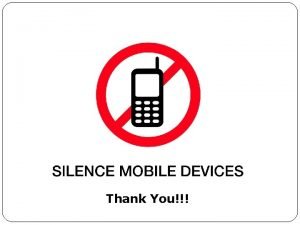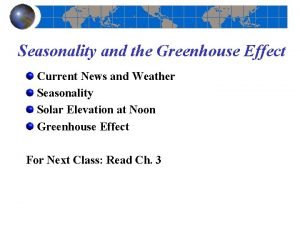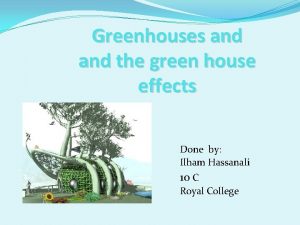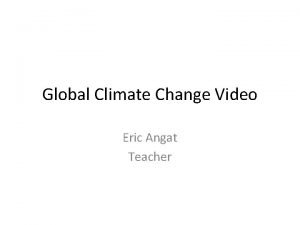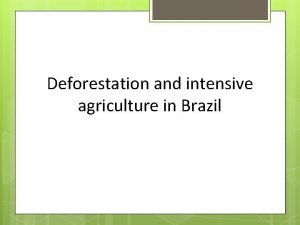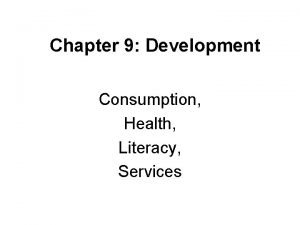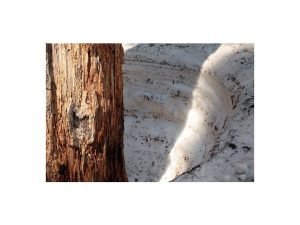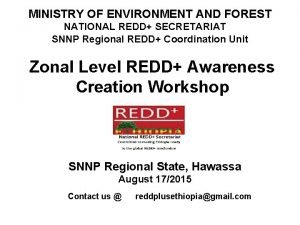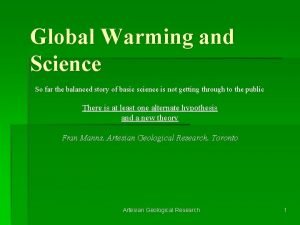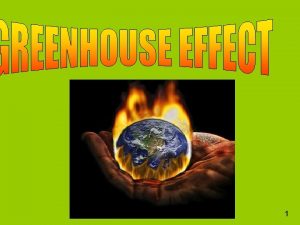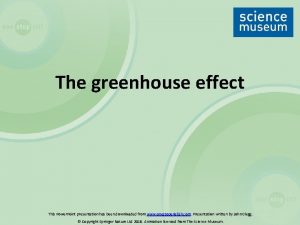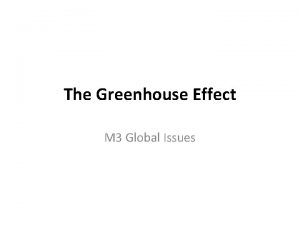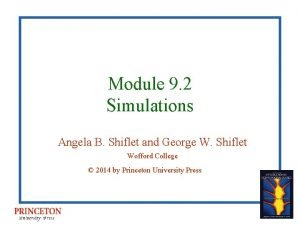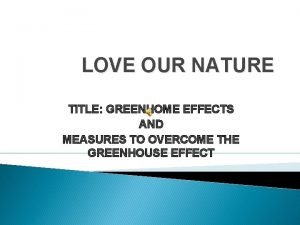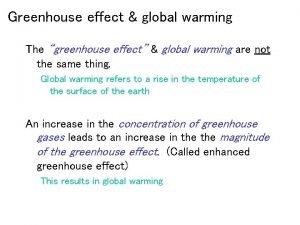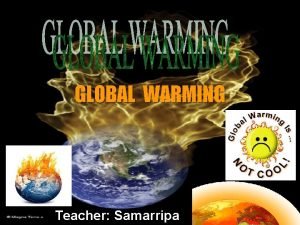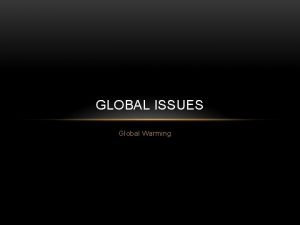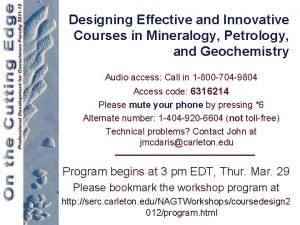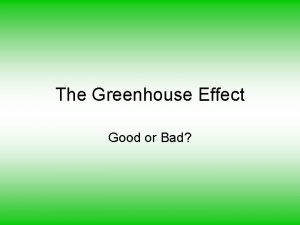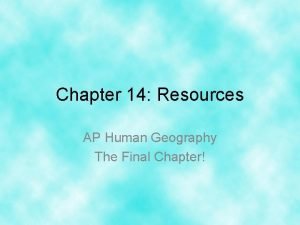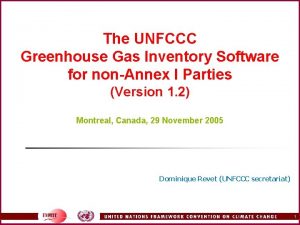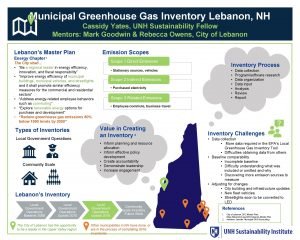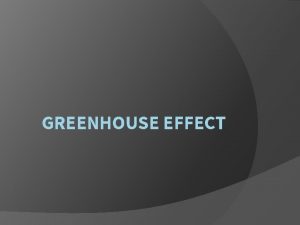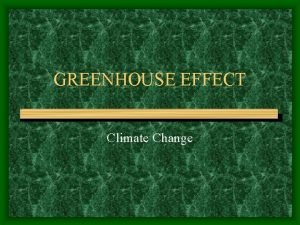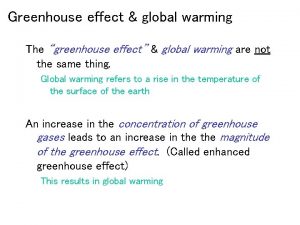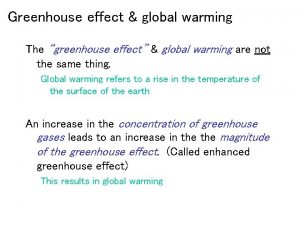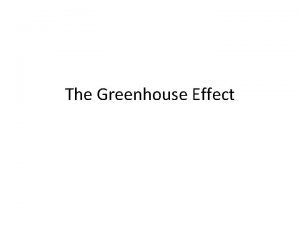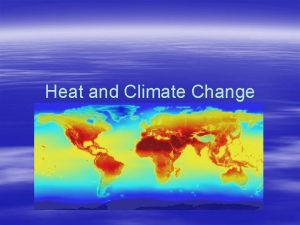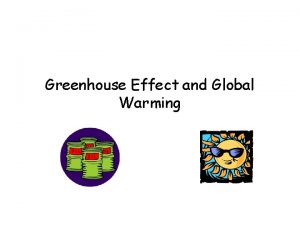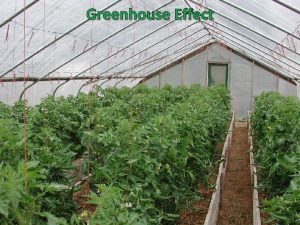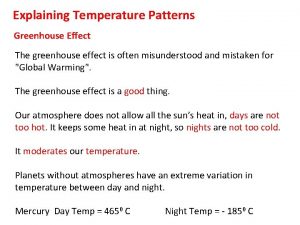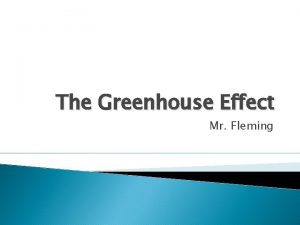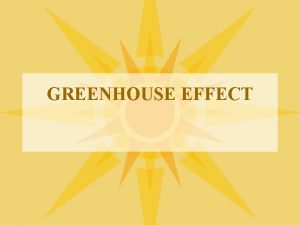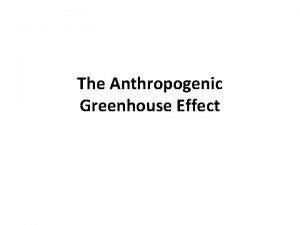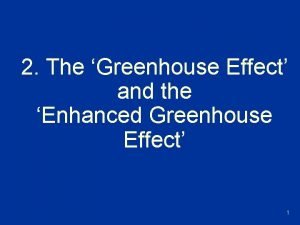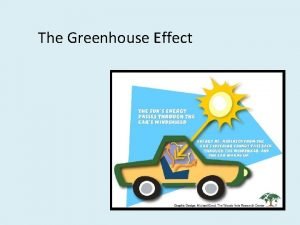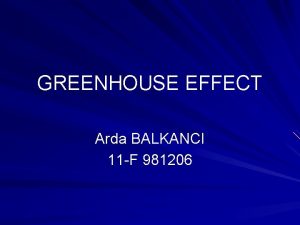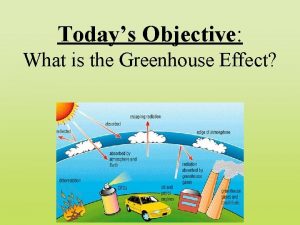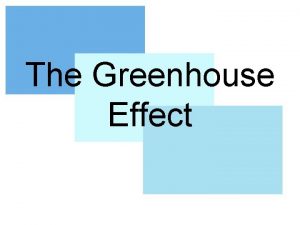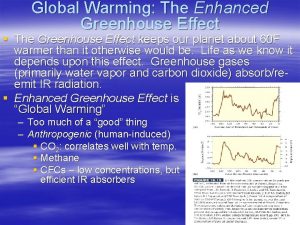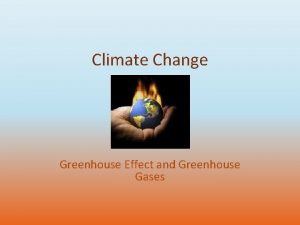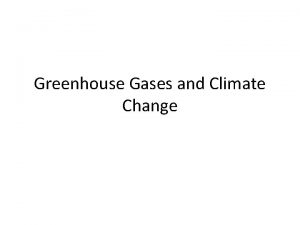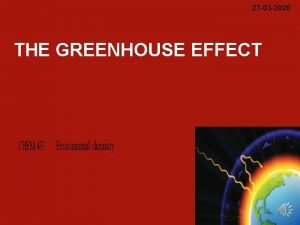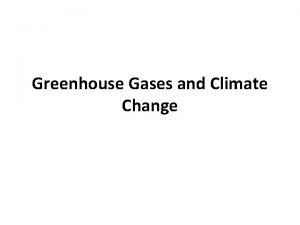UNIT 4 GREENHOUSE EFFECT Lesson 1 Greenhouse Effect



























- Slides: 27

UNIT 4: GREENHOUSE EFFECT

Lesson 1 – Greenhouse Effect � Introduction to climate and climate change � Greenhouse Effect

The Greenhouse Effect � It is a natural process that has been happening for millions of years � Gases and clouds absorb infrared radiation emitted from Earth’s surface and radiate it, heating the atmosphere and Earth’s surface � http: //www. youtube. com/watch? v=Oq. Vy Ra 1 iu. Mc


What if there was no Greenhouse effect? � The Earth’s average global temperature would be -18 o. C instead of 15 o. C

Greenhouse Gases � Any gas in the atmosphere (ie: water vapour, carbon dioxide, and methane) that absorbs lower energy infrared radiation

Greenhouse Gas – Carbon Dioxide � CO 2 makes up only 385 ppm of the Earth’s atmosphere which represents only about 0. 0385% � But, CO 2 is estimated to cause up to a quarter (1/4) of the natural greenhouse effect on Earth � CO 2 molecules have atoms that can vibrate and wiggle in many ways and can absorb different types of energy


Greenhouse Gas – Water Vapour � 2/3 of Earth’s natural greenhouse effect is caused by water vapour in the atmosphere � Amount of water in atmosphere depends on temperature; about 4%

Positive Feedback Loop A produces more of B which in turn produces more of A • example: • someone starts to take drugs, the drug has effects on the body, the body eventually adjusts to the drug, and the person requires more of the drug for the same effect

Negative Feedback Loop -self-regulating system that works to maintain stability • example • Thermostat -the temperature in a heated room reaches a certain upper limit, the room heating is switched off so that the temperature begins to fall. When the temperature drops to a lower limit, the heating is switched on again

Greenhouse Gas – Water Vapour � Water vapour and temperature are related by a positive feedback loop

Greenhouse Gases – Methane (CH 4) � There is less methane in the atmosphere than carbon dioxide � Methane can absorb more thermal energy than carbon dioxide (23 more times)

Greenhouse Gases – Ozone (O 3) � Forms a layer protecting the Earth’s surface from the Sun’s higher-energy UV radiation � Ozone also acts as a greenhouse gas

Greenhouse Gases – Nitrous Oxide (N 2 O) � 300 times more effective than a molecule of CO 2 as a greenhouse gas � Lower levels of nitrous oxide can be found in the atmosphere than carbon dioxide

� The molecule’s increased ability to vibrate will allow for greater absorption of energy


Greenhouse Gases – Changing the Climate � Greenhouse gases have been a part of our atmosphere for hundreds of thousands of years and have contributed to the naturally occurring greenhouse effect

But, what’s happening now? Increases since about 1750 are attributed to human activities in the industrial era.


Anthropogenic (Human Influenced) Sources of Greenhouse Gases � Carbon Dioxide: �Burning fossil fuels (coal, gasoline, natural gas) releases CO 2 �Deforestation – inhibits photosynthesis which would remove CO 2 from the atmosphere; also as left over forest waste decomposes, it produces greenhouse gases

Anthropogenic (Human Influenced) Sources of Greenhouse Gases � Methane �Agricultural activities – rice farming, cattle ranching �Landfills and sewage treatment plants – methane is released as organic material decays �Coal mining and natural gas extraction releases methane

Anthropogenic (Human Influenced) Sources of Greenhouse Gases � Nitrous Oxide �Management of livestock feed and waste �Use of nitrogen fertilizers Chloroflurocarbons (CFCs) � no natural sources of CFCs �Leak out of refrigerators and air conditioners

Anthropogenic Greenhouse Effect � The increase in the amount of lowerenergy infrared radiation trapped by the atmosphere as a result of higher levels of greenhouse gases in the atmosphere due to human activities, which is leading to an increase in Earth’s average global temperature

Carbon Dioxide & Global Temperature � Increases in carbon dioxide levels result in increases in global temperature due to the greenhouse effect; however, increases in temperature can also cause increases in carbon dioxide levels � As the temperature increases, carbon dioxide stored in plants and oceans (carbon sinks) get released

Positive Feedback Loop

http: //www. youtube. com/watch? v=Zz. CA 60 W no. Mk � http: //www. youtube. com/watch? v=g. Lk 5 Y 1 Y Om. O 0 Drought in Brazil – Coffee at risk! � http: //www. youtube. com/watch? v=Sey 5 Q 6 a Ji. M 8 California Drought � Google Ice Storm and Toronto Flood
 Greenhouse effect long and shortwave radiation
Greenhouse effect long and shortwave radiation Why is the greenhouse effect important
Why is the greenhouse effect important Whats a green house
Whats a green house Greenhouse effect
Greenhouse effect Greenhouse effect
Greenhouse effect Enhanced greenhouse effect
Enhanced greenhouse effect How to stop greenhouse effect
How to stop greenhouse effect Global warming 101
Global warming 101 Greenhouse activities
Greenhouse activities Greenhouse effect
Greenhouse effect Greenhouse effect on plants
Greenhouse effect on plants Greenhouse effect
Greenhouse effect Greenhouse effect powerpoint
Greenhouse effect powerpoint Causes of greenhouse effect
Causes of greenhouse effect Greenhouse effect in order
Greenhouse effect in order Conclusion of greenhouse effect
Conclusion of greenhouse effect Greenhouse effect essay
Greenhouse effect essay Greenhouse effect
Greenhouse effect Human activities that enhanced greenhouse effect
Human activities that enhanced greenhouse effect Greenhouse effect in order
Greenhouse effect in order Climate stability
Climate stability Greenhouse effect gif
Greenhouse effect gif Biomass fuel ap human geography
Biomass fuel ap human geography Hyp opp adj triangle
Hyp opp adj triangle Unit 10, unit 10 review tests, unit 10 general test
Unit 10, unit 10 review tests, unit 10 general test Greenhouse inventory management software
Greenhouse inventory management software Deborah greenhouse md
Deborah greenhouse md Cassidy yates
Cassidy yates
